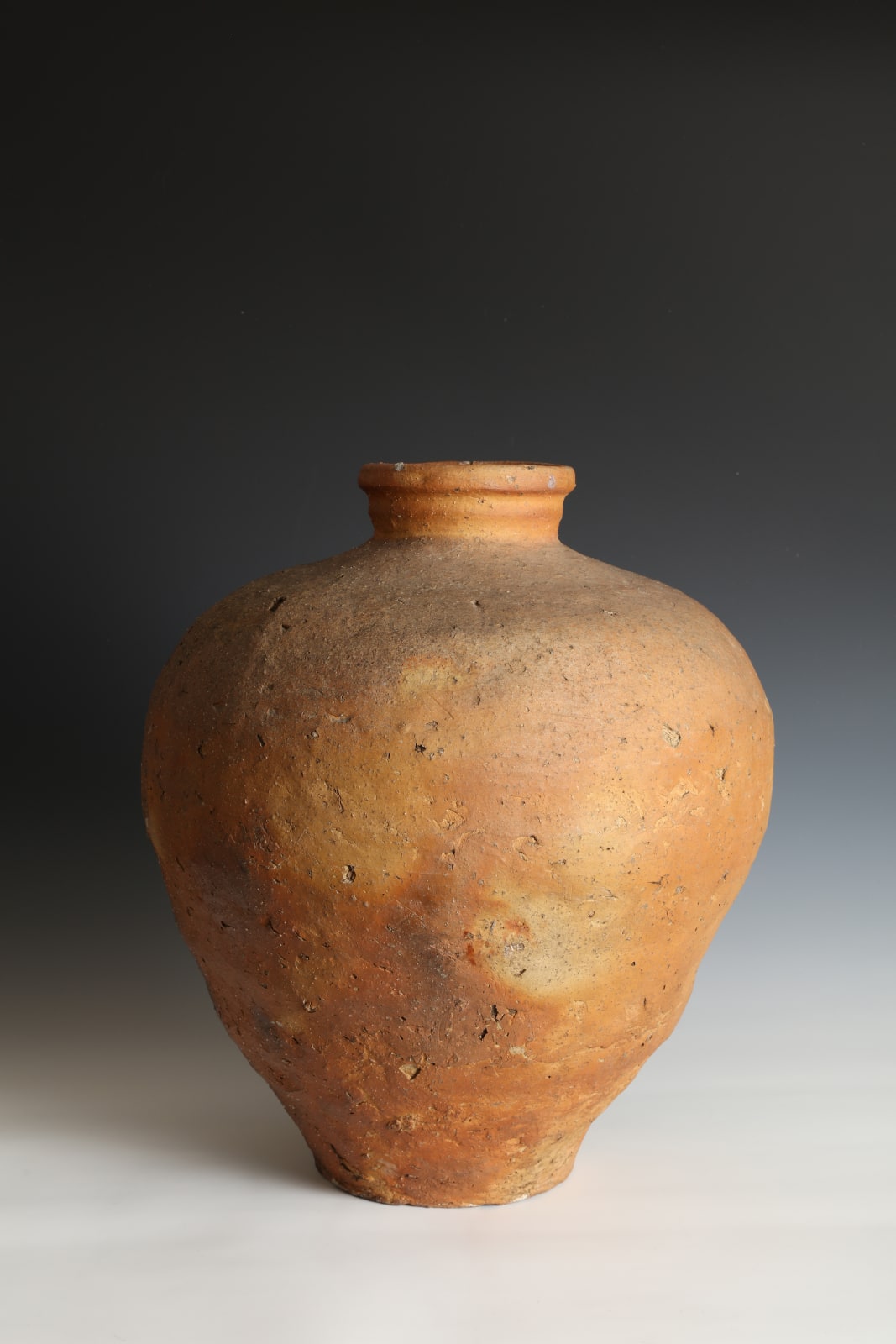Shigaraki Jar, 15th/16th century
Stoneware with natural ash glaze
Size 18½ x 16¼ x 16 in. (47.3 x 41.2 x 40.8 cm)
T-3943
Further images
This imposing, sturdy storage jar was made about thirty miles from Kyoto at the village of Shigaraki, one of Japan’s oldest continuously functioning centers of ceramic production. The jar’s uneven...
This imposing, sturdy storage jar was made about thirty miles from Kyoto at the village of Shigaraki, one of Japan’s oldest continuously functioning centers of ceramic production.
The jar’s uneven profile is due to its having been built up by hand in several stages from coils of damp clay, rather than having been thrown on a potter’s wheel. It has the unmistakable Shigaraki surface, distinguished by grains of feldspar and quartz and fired to a warm orange tone with firing spots; on the shoulder are sand and sediments which fell from the ceiling of the simple tunnel kiln during the firing at temperatures in excess of 2,000 degrees Fahrenheit.
Traditionally numbered among the “Six Old Kilns,” Shigaraki produced large utilitarian ceramics from the twelfth century onwards. Along with the other old kilns, Shigaraki was at its peak during the medieval period but largely fell out of fashion during later centuries until many of Japan’s historic ceramic wares were “rediscovered” some eighty years ago. After World War II, large Shigaraki jars in particular became one of the most sought-after of medieval Japanese ceramics, admired for their rugged, hand-built forms, orange-red surfaces flecked with random crystalline inclusions, and dynamic splashes of ash glaze. Thanks in part to a 1965 catalogue featuring legendary photographer Ken Domon’s dramatic images, by the 1970s virtually no ceramic collection in Japan was complete without a Shigaraki jar. The products of the Shigaraki kilns have also exercised a powerful influence on contemporary ceramic artists, not just those working in Shigaraki, but others throughout Japan and around the world.
From the late fifteenth century Shigaraki was one of the native Japanese wares appropriated by arbiters of taste such as Murata Jukō as “found objects” for use in chanoyu (the Japanese Tea Ceremony). Murata was the first tea master to comment on the “chilled and withered” quality of wares from the old kilns including Shigaraki, noting in a famous letter that these rustic vessels could be used to great effect in combination with more finished and perfect-looking imported Chinese ceramics, then in vogue among the samurai elite. Murata’s preference for the rugged and unfinished was picked up later in the sixteenth century by Sen no Rikyū, widely regarded as the greatest of all tea masters, who developed the concept of wabi-sabi (rustic, unassuming, transient, incomplete) as a key element in Japanese traditional aesthetics.
The jar’s uneven profile is due to its having been built up by hand in several stages from coils of damp clay, rather than having been thrown on a potter’s wheel. It has the unmistakable Shigaraki surface, distinguished by grains of feldspar and quartz and fired to a warm orange tone with firing spots; on the shoulder are sand and sediments which fell from the ceiling of the simple tunnel kiln during the firing at temperatures in excess of 2,000 degrees Fahrenheit.
Traditionally numbered among the “Six Old Kilns,” Shigaraki produced large utilitarian ceramics from the twelfth century onwards. Along with the other old kilns, Shigaraki was at its peak during the medieval period but largely fell out of fashion during later centuries until many of Japan’s historic ceramic wares were “rediscovered” some eighty years ago. After World War II, large Shigaraki jars in particular became one of the most sought-after of medieval Japanese ceramics, admired for their rugged, hand-built forms, orange-red surfaces flecked with random crystalline inclusions, and dynamic splashes of ash glaze. Thanks in part to a 1965 catalogue featuring legendary photographer Ken Domon’s dramatic images, by the 1970s virtually no ceramic collection in Japan was complete without a Shigaraki jar. The products of the Shigaraki kilns have also exercised a powerful influence on contemporary ceramic artists, not just those working in Shigaraki, but others throughout Japan and around the world.
From the late fifteenth century Shigaraki was one of the native Japanese wares appropriated by arbiters of taste such as Murata Jukō as “found objects” for use in chanoyu (the Japanese Tea Ceremony). Murata was the first tea master to comment on the “chilled and withered” quality of wares from the old kilns including Shigaraki, noting in a famous letter that these rustic vessels could be used to great effect in combination with more finished and perfect-looking imported Chinese ceramics, then in vogue among the samurai elite. Murata’s preference for the rugged and unfinished was picked up later in the sixteenth century by Sen no Rikyū, widely regarded as the greatest of all tea masters, who developed the concept of wabi-sabi (rustic, unassuming, transient, incomplete) as a key element in Japanese traditional aesthetics.
Exhibitions
TEFAF 2016
1
of
13











